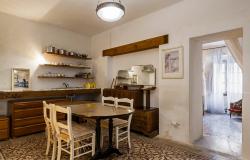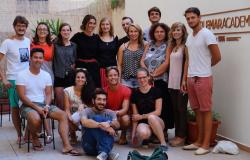I am proud to live in a place which saw off a McDonald’s in favour of its own food but this does not mean that the Sicilians shun fast food: far from it, as rosticcerie, bars and supermarkets all vie with one another to produce stunning arrays of focacce, girelle [which I call “whirly bread] other savoury pastries and, of course, the sublime arancini [filled rice balls] at lunch time and in the evening.
Rome has its supplì and other Italian regions produce focacce but supplì are not arancini and a Sicilian focaccia has mouthwateringly thin pastry, is perfectly folded and does not have holes filled with rosemary and seasalt on top.
Why are the Sicilians so good at producing these foods? The answer lies in their Arabic heritage and also in a Sicilian tradition which developed through necessity, that of frugality. It was the Arabs who brought rice to Sicily and they would serve large bowls of saffron- flavoured rice with condiments which diners ate with their hands. The bite-sized pieces of rice which the diners picked up and moistened with a little sauce probably formed themselves into balls by accident. Later the balls were breaded and fried by the chefs of the Court of Federico II, who liked them this way because they could be carried on long journeys or hunting trips. Ordinary Sicilians began to make arancini with the leftovers of risotto. Meanwhile focacce were made from leftover pasta dough which had been prepared only with flour, water and yeast.
Now we come to a much-exercised linguistic debate: Some people say “arancini” [masculine plural] whilst others insist upon arancine [feminine plural]. Even my Modican friends don't know why and some of them are mother-tongue teachers of Italian. Logic would lead you to suppose that the correct form is arancine, as the -ina suffix means "little" and the word is a diminutive form of arancia [orange] which is feminine. But a couple of years ago I came across an article which stated that the feminine form is only used in Palermo and Agrigento and that the masculine form is used elsewhere in Sicily. I have seen and heard both forms in Modica so it seems that here, at least, you can take your pick. On facebook there is a campaign for the use of the feminine form.
Well, those are the historical and linguistic aspects. Now let’s talk about the eating! There is something incredibly comforting about walking home in the evening and catching the aroma of freshly made arancini wafting towards you from a bar or rosticceria. In my small, local rosticceria you will find an enormous selection of focacce, girelle, small pizze and other pastries but it is the arancini which sell the fastest. You can choose from the traditional ragù filling, a spinach filling or round arancini filled with ham and cheese. You tell the assistants how many “pezzi” [items] you want and then you make your selection. A “5 pezzi” tray of these culinary delights will cost only €6.50. If you are having a party, several butchers and supermarkets sell “arancini mignon” or mini-arancini and bars are also fond of serving these with aperitivi at lunchtime.
Some arancini are round and some are conical. No one knows why but you used to be able to tell which filling the arancino contained from its shape. This is no longer true so shape is a matter of preference. Even the round arancini have a little point in Catania, a homage to Etna perhaps.
Have I ever made arancini? Yes, and they weren’t too bad. But making them is a messy business which demands much “pazienza” and personally I think that when, as often happens, I am consumed by the desire for arancini, it is time to swallow my cook’s pride and make for the rosticceria .







